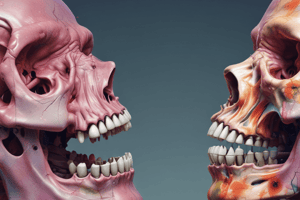Podcast
Questions and Answers
What is a contusion?
What is a contusion?
A contusion is also known as a bruise, occurring when blunt force trauma causes damage to blood vessels beneath the skin.
What symptoms may indicate a more serious injury associated with contusions?
What symptoms may indicate a more serious injury associated with contusions?
Symptoms such as numbness, tingling, or loss of function may indicate a more serious underlying injury.
Acute strains occur as a result of a single event, such as a sudden ______ or fall.
Acute strains occur as a result of a single event, such as a sudden ______ or fall.
twist
Chronic strains develop suddenly as a result of repetitive movements or prolonged stress on the muscle.
Chronic strains develop suddenly as a result of repetitive movements or prolonged stress on the muscle.
What are common symptoms of an acute strain?
What are common symptoms of an acute strain?
Which of the following is NOT a nursing assessment for strains?
Which of the following is NOT a nursing assessment for strains?
For injuries, the RICE protocol stands for Rest, Ice, Compression, and ______.
For injuries, the RICE protocol stands for Rest, Ice, Compression, and ______.
What grade of sprain involves a complete tear of the ligament?
What grade of sprain involves a complete tear of the ligament?
What does the term 'dislocation' refer to?
What does the term 'dislocation' refer to?
Flashcards are hidden until you start studying
Study Notes
Contusions: Definition and Assessment
- A contusion, commonly referred to as a bruise, results from blunt force trauma damaging blood vessels under the skin, leading to bleeding and discoloration.
- Assessment involves examining size, color, location, swelling, and pain levels, documented on a pain scale.
- Red flags include large contusions over vital organs or symptoms like numbness, tingling, or loss of function, indicating possible fractures or internal bleeding.
- Immediate care includes applying ice to reduce swelling and pain, and elevating the affected area when possible.
- Continuous monitoring for signs of compartment syndrome or internal bleeding is crucial.
- Educate patients on proper home care and indicators for seeking further medical attention.
Strains: Definition and Types
- A strain is an injury to a muscle or tendon from being stretched beyond its capacity, often due to overstretching or overuse.
- Acute strains occur suddenly from a single incident, such as twisting or falling, causing pain, swelling, and muscle spasms.
- Chronic strains develop progressively from repetitive movements or prolonged stress, leading to pain, stiffness, and reduced range of motion.
Nursing Assessment for Strains
- Pain should be assessed for severity, location, and nature.
- Range of motion is crucial to assess limitations in the affected area.
- Test and compare muscle strength of the affected group with the uninjured side.
- Observe for visible swelling and bruising, documenting their extent.
Nursing Management for Strains
- Rest is essential; patients should avoid activities that worsen the strain.
- Compression involves using elastic bandages to minimize swelling and provide support.
- Ice application helps reduce inflammation and pain.
- Elevation of the affected area above heart level assists in reducing swelling.
Sprains: Definition and Grading
- Grade I: Mild sprain with stretched ligament but no tear.
- Grade II: Moderate sprain involving a partial tear of the ligament.
- Grade III: Severe sprain with a complete tear of the ligament.
Nursing Assessment for Sprains
- History taking involves gathering information on the injury mechanism and symptom onset.
- Physical examination includes assessing swelling, bruising, and joint stability.
- Pain evaluation uses a pain scale to quantify discomfort levels.
- Functional assessment evaluates the ability to bear weight or use the affected joint.
Nursing Management for Sprains
- Implement the RICE protocol: Rest, Ice, Compression, and Elevation during the acute phase.
- Provide pain management through prescribed medications and education on their usage.
- Rehabilitation involves guiding patients through range-of-motion exercises and gradual return to activity.
Dislocations: Definition and Types
- Dislocation occurs when the bones forming a joint are displaced, often requiring medical intervention for repositioning.
- Common sites of dislocation include shoulders, fingers, and knees, highlighting the importance of quick assessment and management.
Studying That Suits You
Use AI to generate personalized quizzes and flashcards to suit your learning preferences.




